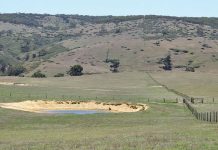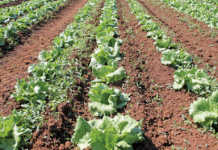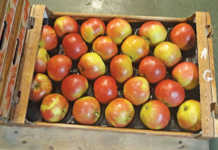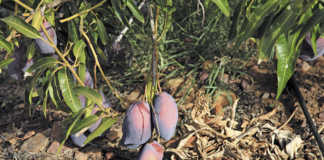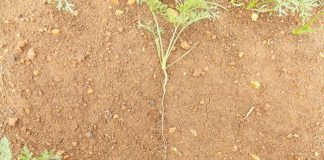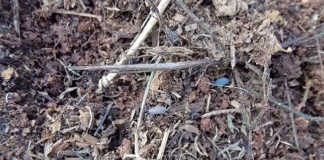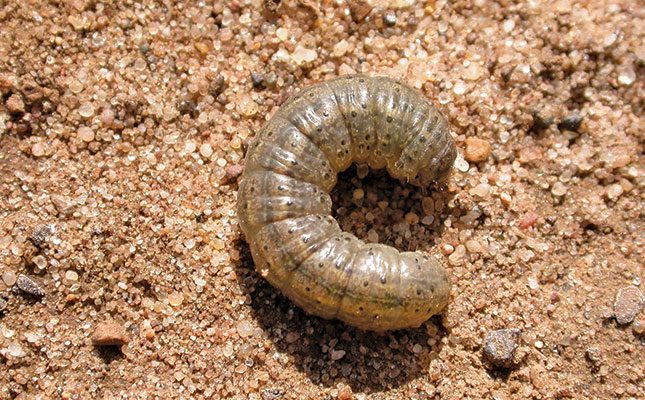
Photo: Supplied
The common cutworm, Agrotis segetum (Lepidoptera: Noctuidae) is a destructive pest of maize, especially in the Highveld region of South Africa. Over the three previous cropping seasons, many reports of control failure have been made throughout the region.
Although there is speculation regarding insect resistance to insecticides, the observed control failures are most likely due to other factors, such as larval behaviour and environmental conditions, and, notably the presence of weeds.
Why is it difficult to identify cutworm?
Identification of cutworm as the pest responsible for injury to seedlings in a particular land is difficult due to their habit of tunnelling into the soil during the day and feeding at night.
It is therefore difficult to detect larvae to associate with the observed damage symptoms, which could possibly also be due to other soil insect pests.
When damaged or dead seedlings are observed, the soil around the base of the plants should be examined for the presence of cutworms. Larvae can be observed beneath clods, inside their tunnels, or in soil cracks.
Signs of cutworm infestation
Cutworm damage is influenced by the quantity and size of larvae present in lands. Only if seedlings are seriously damaged and when stand loss occurs, can damage be considered economically important.
Damage symptoms to maize seedlings can be grouped into five categories, depending on the size of the larvae and the age of the plant.
- Stand loss
In row crops such as cotton, maize and sorghum, loss of plant stand is often the first symptom that cutworms may be present in a field. A single larva may sever several seedlings and will often cut one plant and move on to the next.
In cases where cutworm infestations are severe, it could even appear as if some of the rows have disappeared as early as four days after seedling emergence. In these instances, it may be necessary for producers to replant.
- Small holes in furl leaves of seedlings
When moths lay their eggs on or below young seedlings, the L1 and L2 larvae that hatch from these eggs develop and feed on the furl leaves of the seedlings. Foliar feeding can be seen as early signs of cutworm infestations.
The type of feeding can be distinguished from other maize pest damage as shot-hole-like holes that appear on the leaves of seedlings.
- Severed young seedlings
The feeding pattern of cutworm larvae change from the third instar (phase between two periods of moulting) and they now have a negative reaction to light and they hide below ground during the day.
Larvae emerge from the ground at night and move from plant to plant, severing young seedlings just above or at a short distance below the soil surface. In many instances, only one plant is consumed, being partially or entirely pulled underground and eaten.
- Large holes in stems of older seedlings
Larger larvae (L4-L6) are the most damaging and commonly present at the four-leaf stage of maize seedlings. By this stage, maize seedlings are less prone to costly damage by larvae because stems are too thick to cut off entirely.
However, a clean round hole is eaten into the plant’s stem. This type of feeding damage is not typically seen, unless deliberately sought after.
- Wilted seedlings
Producers commonly confuse cutworm damage with other maize pests such as false wireworm (Somaticus spp.) and black maize beetle (Heteronychus arator).
The damage inflicted by black maize beetle and false wireworm is similar to cutworms, but has a more frayed appearance than in the case of cutworms.
The symptoms observed above-ground, however, correspond to that of a plant attacked by these pests and are visible as wilting of the central whorl leaf, followed by wilting of the entire plant.
The plant’s growth stage at the time of attack is important with respect to its ability to survive cutworm injury. A plant cut below the growing point will not recover. Seedlings injured above the growth point may sometimes regrow, but often do not recover fully.
Host plants (weeds)
Apart from maize, other crops affected by this pest include groundnut (Arachis hypogaea), asparagus (Asparagus officinalis), sunflower (Helianthus annuus), lucerne (Medicago sativa), tobacco (Nicotiana tabacum), potatoes (Solanum tuberosum), sorghum (Sorghum bicolor) and wheat (Triticum aestivum).
As in the case of many other insect pests, weedy host plants play an important role in their biology and behaviour. Cutworm larvae commonly feed on available weed species, where they develop into larger larval stages before attacking seedlings of newly emerged crops. Overwintering is a common phenomenon among cutworms.
Larvae slowly develop from eggs laid during autumn and winter will remain active beneath winter weeds until they reach the last larval stage.
It can therefore be said that the presence of these weed species during winter months up to planting nearly guarantees the presence of large larvae (the most damaging stage) at planting time.
For this reason, weed management practices are commonly suggested and considered the key to successful cutworm control in the period prior to crop establishment.
As newly hatched cutworm larvae rely on weeds for a food source when maize seedlings are not available, clean cultivation to remove weeds, four to five weeks prior to planting, is needed to ensure that larvae starve to death before seedlings emerge.
However, since most farmers plant herbicide-tolerant maize, clean cultivation is not commonly practised anymore, leading to cutworm problems. This is also the case in some conservation farming systems where weeds are present in fields until close to the time that seedlings emerge.
It may therefore be necessary to apply herbicide to kill weeds four to five weeks prior to planting, with the disadvantage that a follow-up application may be needed after seedling emergence.
While weeds may not be present at the time when producers aim to plant, their presence four to five weeks beforehand will influence the abundance of cutworm populations.
It is recommended that cultivated fields be kept bare of weeds and crop residues 35 days before planting in order eradicate cutworms by means of starvation.
Additionally, tillage conducted well before planting brings larvae to the surface, leaving them exposed and vulnerable to attacks from birds and frost.
By removing weeds from fields, cutworm moths and larvae are deprived of their preferred oviposition and feeding sites. The assumption is thus that cutworm populations in conventionally tilled fields should be considerably lower than fields practising no-till.


